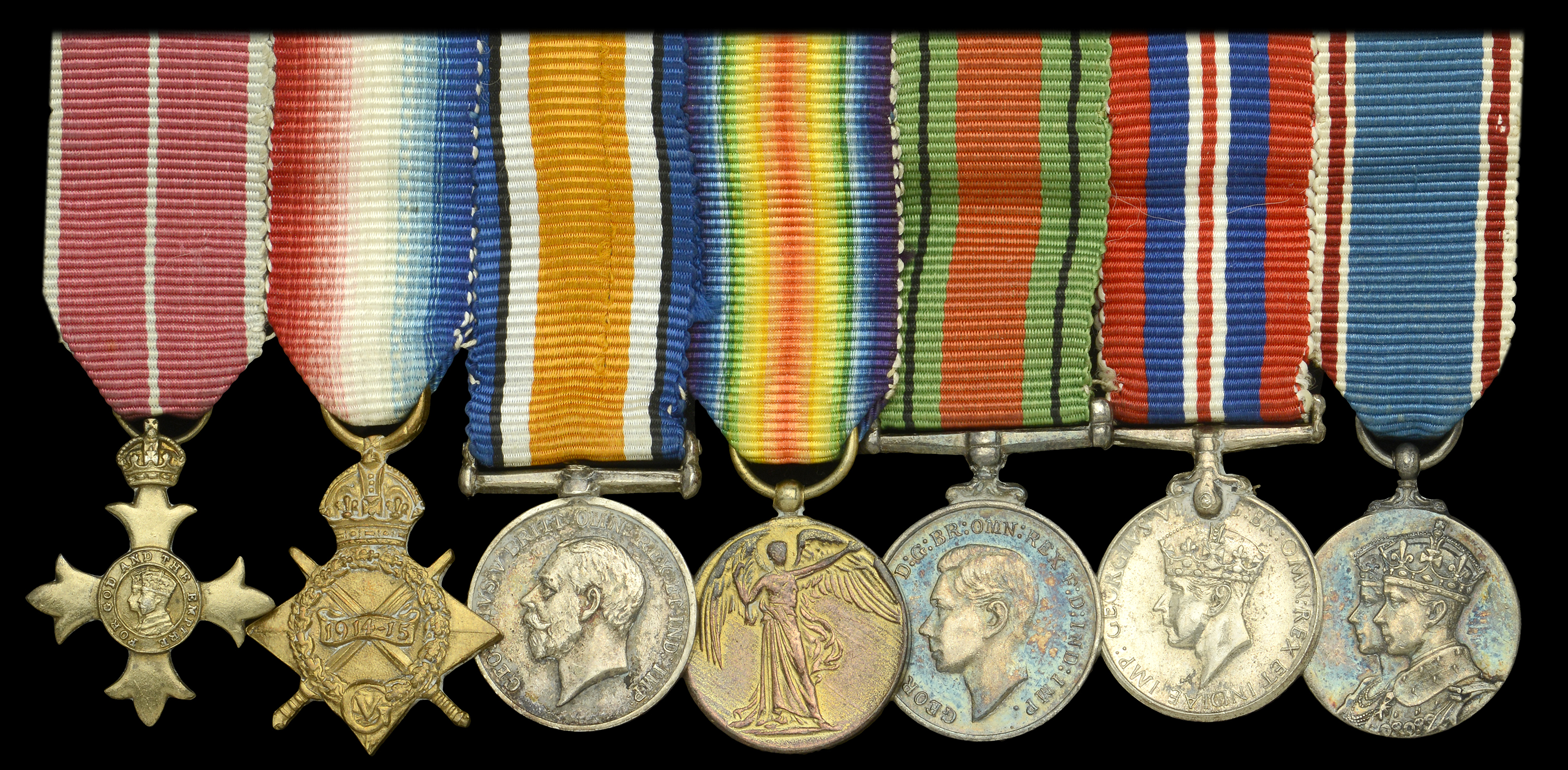The mounted group of seven miniature dress medals attributed to/ representative of those worn by Engineer Captain S. F. Heraud, Royal Navy The Most Excellent Order of the British Empire, O.B.E. (Military) Officer’s 2nd type badge, silver-gilt; 1914-15 Star; British War and Victory Medals; Defence and War Medals 1939-45; Coronation 1937, mounted as worn, very fine and better (7) £60-£80 --- Importation Duty This lot is subject to importation duty of 5% on the hammer price unless exported outside the UK --- --- Provenance: Dix Noonan Webb, June 1998. O.B.E. London Gazette 1 January 1946. M.B.E. London Gazette 17 July 1919: ‘For valuable services in H.M.S. Iron Duke, 1st Battle Squadron.’ Stanley Francis Heraud was born in Bristol in November 1891 and entered the Royal Navy as a Boy Artificer in August 1907. An Engine Room Artificer 3rd Class in the battleship Superb by the outbreak of hostilities in August 1914, he removed to the cruiser Achilles in March 1916 and was present at her famous duel with the German raider Leopard on 16 March 1917, in the company of the armed boarding steamer Dundee - after a two hour engagement, including a torpedo hit delivered by the Achilles, the Leopard was sunk with all hands, among them Dundee’s original boarding party. Advanced to Acting Mate, R.N. in May 1917, Heraud served in the Iron Duke from June 1917 until July 1920, in which period he saw action against the Bolsheviks in the Black Sea, and assisted in the ‘wrecking of engines’ of the enemy ships based at Theodosia in the Crimea. For his services he was appointed a Member of the Order of the British Empire. An article published by Richard C. Witte (a sometime owner of Heraud’s full-sized awards) in the O.M.R.S. Journal gives further details: ‘In November 1919, Mate Heraud was detached, with three hours’ notice, to take over as Chief Engineer of the relatively new Russian battleship Volya which was interned at Izmid, Turkey, in the Sea of Marmora. She had been the Imperator Aleksander III in the Czarist Navy and had been under the German flag at Sebastopol from May 1918 until the end of the War. She had been taken to Izmid by the Royal Navy in April 1919 to keep her out of Bolshevik hands. She was in bad condition. In nine days, however, Heraud got Volya’s machinery in working order so she could be sailed back to Sebastopol - Denekin’s White Army victories made this possible. He was assisted by ratings from Iron Duke and the Russian sailors remaining in Volya. In the passage to Sebastopol, Heraud experienced a great storm and was without sleep for 35 hours, steaming 14 knots and arriving at Sebastopol just before dark. He reported that it was difficult to get through the Straits of Bosphorus on the way. Heraud remained with the Russians for a month as ‘British Engineer to the Russian Admiralty’, instructing the Russian Engineer Officers about Volya. He saved many letters he received complimenting him on the Volya trip, including one from Russian Admiral Nenkoff, Commander-in-Chief.. Between the Wars, Heraud served in Malta Dockyard in the mid-1920s and was Engineer Lieutenant-Commander in the new destroyer Amazon from 1928 to 1931, a ship with advanced and experimental machinery - her first major cruise was 20,000 miles around South America. Further seagoing appointments in the Wallace and Shropshire in the 1930s followed, the latter ship assisting in the rescue of passengers from the stricken Italian liner Ausonia at Alexandria in October 1935. Finally, about the time of the renewal of hostilities in 1939, he came ashore to take up an appointment in Chatham Dockyard, where his speciality was gunnery mounts. He was placed on the Retired List as an Engineer Captain in 1944, but actually remained employed at Chatham until 1947,, ansd was advanced O.B.E. in the 1946 New Year’s Honours’ List. He died in 1962. Note: The recipient’s full-sized medals sold in these rooms in December 2007.
Auctioneer's Buyers Premium: 24% (+VAT)
There is an additional charge of 4.95% (+VAT/sales tax)
See Full Terms And Conditions





